Get in shape this back to school season with these steps to nail your campaigns.
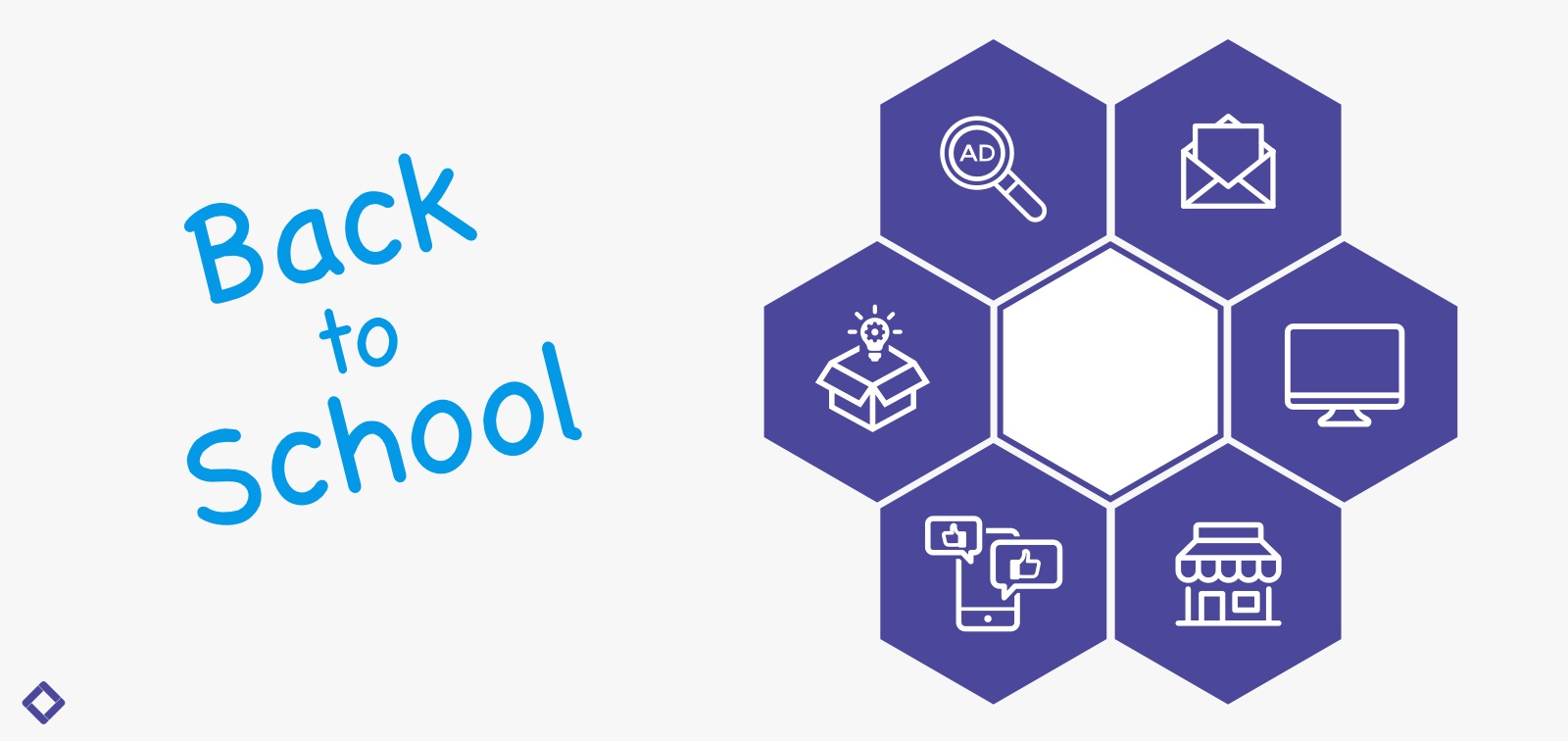
Get in shape this back to school season with these steps to nail your campaigns.
Tell me why I Don’t Like Mondays…
Back To School season is upon you, and contrary to the Boomtown Rats, that first Monday of school is exciting.
Yes, your competition is capitalizing on Back to School trends, post-pandemic behavior has changed the face of consumerism, and it's up to you as an eCommerce marketer to come up with unique and exciting campaigns.
Not only that, but omnichannel is all the rage. Your campaigns have to be data-driven and work across your company's channels.
So how do you get started?
Here are seven ways to nail your Back to School marketing omnichannel.

Back to School spending in 2019 reached a record high for both college and high-schoolers at around 80.7 billion dollars in the US.
Before the pandemic, Back to School was the second biggest retail-spending season (so, the second Most Wonderful Time of The Year).
So what about after?
Contrary to what you may be thinking, back-to-school spending actually increased.
That's right.
Parents are gearing up to spend on at-home schooling equipment with verticals like electronics, technology, and home furnishing taking over.
60% of shoppers are likely to start shopping approximately 4-6 weeks before school starts.
This means that for your marketing campaigns, it's important to start early enough to get your Back to School ads, emails, and content out before your customers begin their shopping extravaganzas.
For new apparel lines, sales, or discount offers, timing is key.
But in order to assess timing and get creative with Back to School marketing, you first need to understand what the market is like i.e.:
To do is,
Basically, it all boils down to:
Identifying opportunities to accelerate revenue growth.
Simple, right?
Yet with everybody jumping onboard new back-to-school trends, it’s up to you to be pioneers and innovators in the digital marketing space.
In high school, I was more of a supplies-over-shoes kind of gal. But if I could go back to those prepubescent days, I would have definitely persuaded my parents to invest in Heely’s wheelie-shoes.
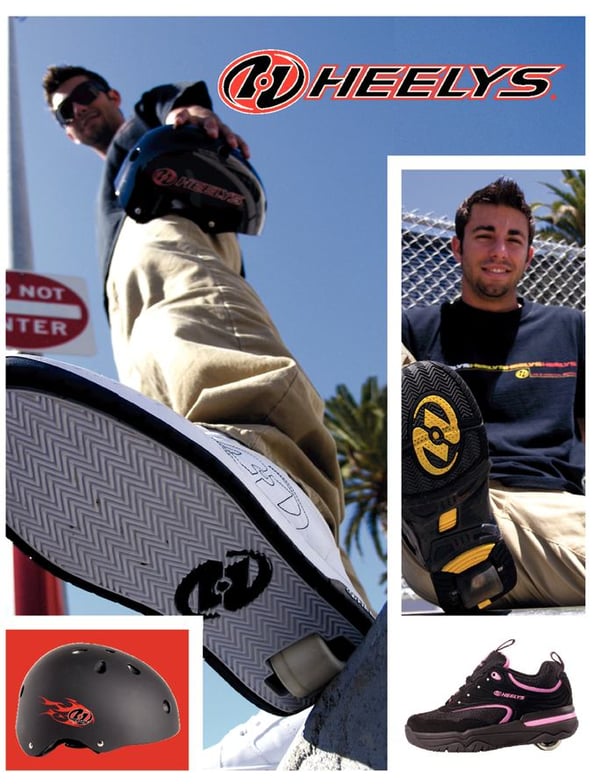
Those were just the coolest.
Indeed, children will likely inform over 21 billion dollars of Back to School spending, with the highest influence on clothing and accessories at 77%.
With kids going back to in-person learning, 69% say they plan to spend the same (or more) on apparel, a slight increase from the average.
Thus, optimize your campaigns omnichannel - from mobile to in-store - especially appealing to the purchasing power of millennials and Gen Z.
To me, going “Back to School” meant fitting in and finding friends. These days, looking “fresh” is just as important.
Be the retailer that can provide products for each of these back to school desires.
This goes hand in hand with,
Allowing all departments to have access to your back to school market research to manage overlap, save time and money, and create consistent and cohesive business goals.
And guess what?
90% of shoppers plan to be active already late July...
So while market research and customer data are a continuous process for any marketing campaign, how do you achieve seven easy steps to roll it out?
By now you know how important social media is as a platform to raise awareness about your brand and target your followers with social ads to keep them engaged.
But using social media should be done in an honest and beautiful way.
Meaning: don’t spam your audience and be transparent with their data use.
And make it b-e-a-utiful!
Many shoppers only respond to ads that have personalized copy and visuals. Your social media strategy should leverage colors and design.
Once you’ve done that,
Invest in Facebook, Instagram, and Tik-Tok ads in real-time by using live stories (you could also use Snapchat, which has 203 million active users per day).
What’s also important is to establish your target audience. You may think Facebook is the number uno right now, but amongst Western hemisphere GenZ, Facebook is “dead”.
Furthermore, 16 to 24-year-olds spend an average of 3 hours per day on social media.
Tweens and their parents will use social media to compare prices and quality for back-to-school products. You want to be there with the best-in-class ads that aren’t spammy, providing honest reviews on all your products.
Micro-influencers are a low-cost option for promoting your products on social media, and they also provide peer reviews.
What’s all the fuss with reviews, you ask?
Both good and bad reviews drive purchase behavior.
This is called the “Blemishing Effect” and boosts the credibility of both the brand and product (yes, even the bad reviews, because they are honest).
Why bring up psychology?
If you haven’t heard this before, we are behavioral experts here at Crobox.
And although the psychology of back-to-school marketing may seem straightforward, it's still important to understand.
Especially if you're leveraging social media (in itself a form of Social Proof) to provide you with the tools for one-on-one customer engagement.
The Psychology of Back to School is simple:
This is a stressful time full of social pressure for students. Many have to readapt to the new normal.
Parents will try to motivate their children to succeed by shopping for best-in-class gadgets at the most convenient prices.
Social media provides the platform for children to see what products their peers are buying, and how they are dressing. Harnessing the power of popular social media sites will:
Ok, that’s our little bit on psychology - we couldn’t help it (and we’ll do it again later. Sorry. Not sorry).
What’s next?
If you have a pretty banner suggesting a sale on supplies and this comes out all wonky on a tablet...well, how do you think your customers are going to react?
Instead, make your site responsive.
In other words, build your site in such a way that the displays, buttons, fonts, and images are adapted by device.
Having a back to school category page that is easy to find is key. If your website is too complex and hard to navigate, this will increase bounce rates and churn.
Think about making your product taxonomies dynamic, so that they display what's important to the individual during which season.
Walmart does this incredibly well, by sub-categorizing Back to School shopping by age-cohort:
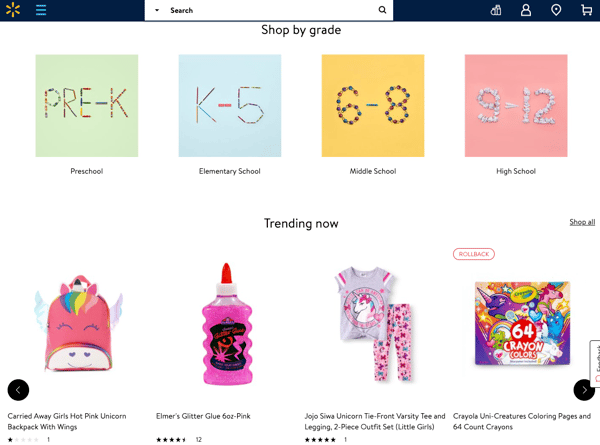
Optimize your product taxonomies for SEO, create easy-to-navigate categories, and elevate your product discovery.
One more thing about banners:
They’re cool but may detract from the actual focus of your brand. IKEA’s Back to School section is an example of staying true to their branding, whilst still capitalizing on the trend:
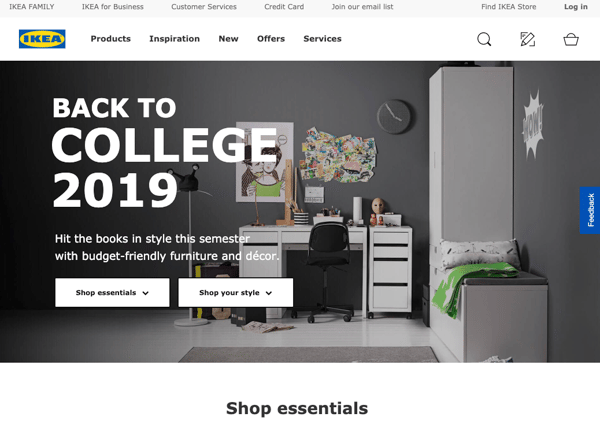
Furthermore, what’s great about this IKEA Back to School landing page is that they understand who their shoppers are and have two categories that appeal to each of these segments:
Email campaigns: the joy of marketing and letting your customers know, hey, I remember you, and here are some cool products you might like.
Email campaigns are proven to improve customer acquisition and retention.
But where do you begin?
Firstly, use your customer data to segment your audience according to their demographics or psychographics to increase the relevancy of your campaigns.
I.e: Who are you targeting with your 2 for 1 notebook sale? Is it,
If you create an email campaign suggesting your new Miley Cyrus-themed handbag line to a Jansport-totting boy of 16, this may not go down well.
Without applying customer segmentation you could end up alienating your customers.
Another important way to segment is based on behavior. See how your already acquiesced customers are interacting with your products across different channels.
Of course, given the rise of data protection laws, it's possible you can only track your customers in-session. Which is how we do data at Crobox. Here are a few tips:
1. Track how your customers interact with your messages (like badges, notifications, dynamic product descriptions) to see what drives click behavior
2. Track how your customers engage with your product messages (which attributes drive behavior and which don't)
3. Track how your customers navigate your webshop, which filters they use, which categories they explore in relation to each other (for behavioral segmentation)
Once you understand your customers' search and discovery behavior on-site, you can reuse this data in your back-to-school email marketing.
For example, Staples launched this in 2016:

They tracked how people shopped online and found out that:
Knowing this, the copy of the email highlights their seasonal discounts to better drive behavior from email back to their webshop.
Additionally, the Staples campaign was released omnichannel, where they had the “Staples Guy” talking through Back to School essentials on TV, radio, and youtube.
The year after, Staples’ Back to School campaign related to teachers, even giving them a chance to enter a competition to win 10k. They tracked on-site behavior to see that their high-value customers were teachers over parents or students.
Great stuff, right?
Staples becomes not just a supply-center, but a source of information for a variety of audiences. Coupled with their nationwide low prices and data-driven marketing, they have little competition during back-to-school in the US.
You can tailor your email copy by grounding them in any of Cialdini’s weapons of influence to help your shoppers make better purchase decisions.
For example, do your customers respond to “Scarcity” messaging?
Check out this Back to School email that leverages this persuasion technique with the message, "Ends Today":
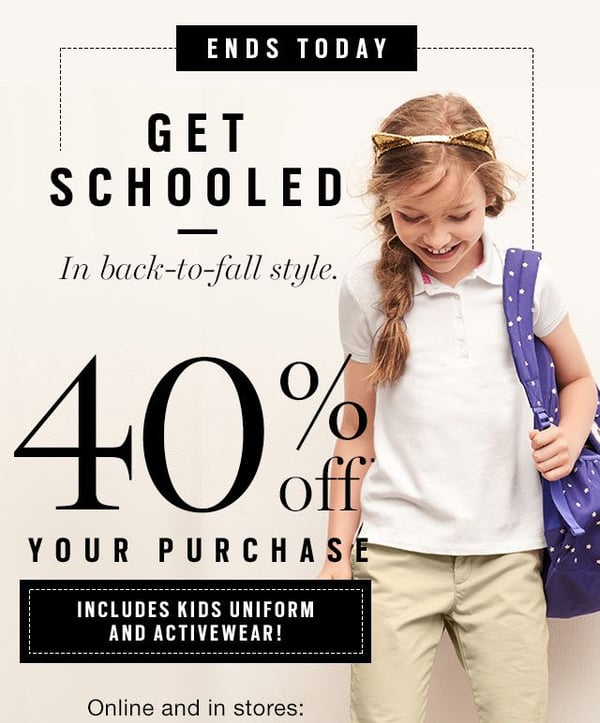
If you want to test your messages, try experimenting with different copy-variants.
Scarcity messaging can be,
54% of total back to school spending used to be on apparel and electronics.
Yet although apparel has remained the most purchased sector over the past years, electronics is on the rise. Electronic gadgets are 50% bought online, making them the most bought category by channel.
"Last year, many families made sizable investments to set up at-home learning environments. This year, some may be upgrading their spaces in preparation for another year of virtual or hybrid learning. And of course, college-bound kids will always be looking for electronic essentials as they equip their dorm rooms with the latest and greatest tech." - Retail Dive 2021
Therefore, have an electronics section that is easy to find on your webshop.
According to Fortune, parents are 81% more likely this year to spend on safety equipment like sanitizer and masks, and 67% more likely to spend on remote learning tools.
The traditional push for apparel has now shifted. It's all about safety first, people.
So you could guide the sale of your top-performing products using product finders or product quizzes
Guided selling lets you control the funnel, giving autonomy back to your shoppers and matching them with the perfect products that fit their needs. Nudge and guide them through the funnel with behavioral principles.
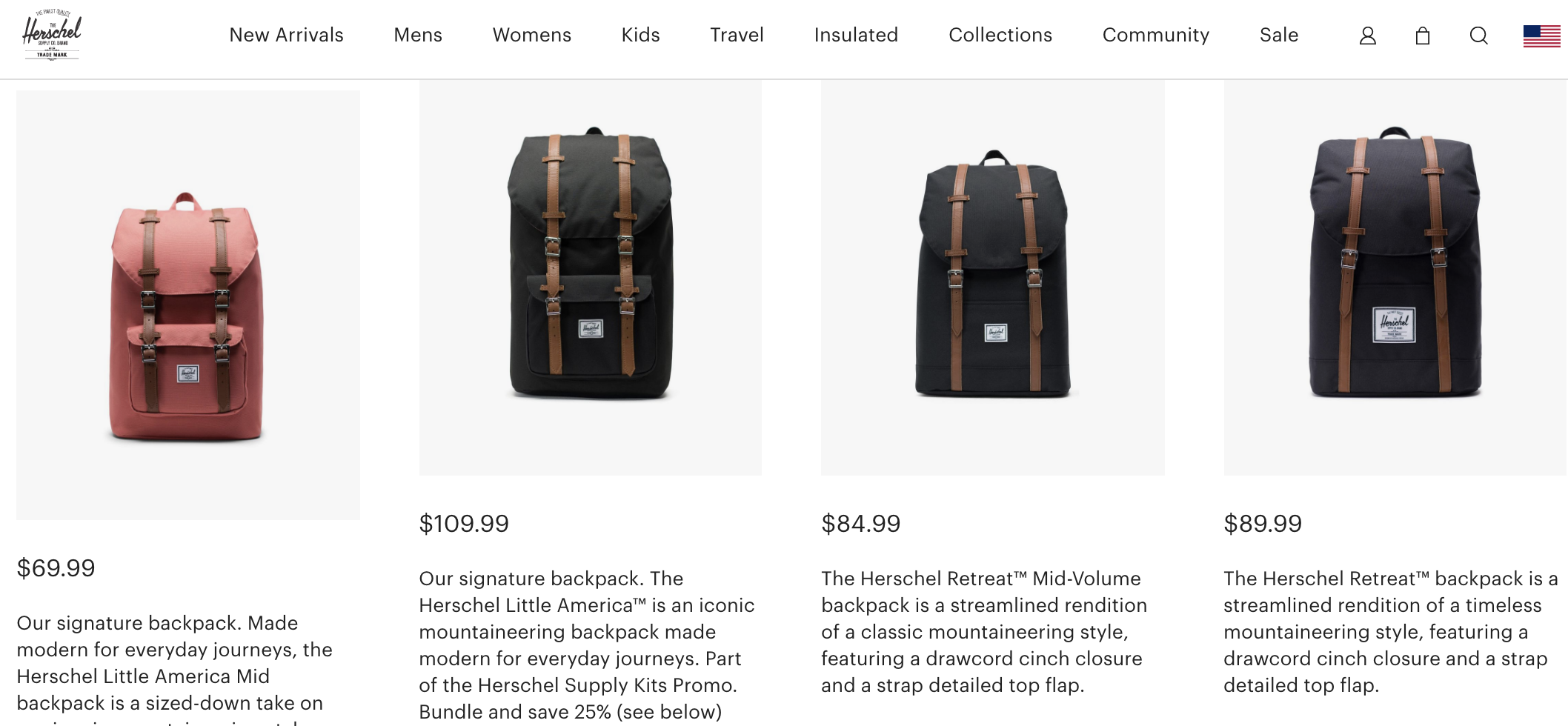
When people pick a product, they need help. Product comparison is one way to guide your shopper's purchase behavior.
Another way to drive behavior and help your shoppers out is to appeal to the behavior of being the new kids on the block. Mondays back to school are a chance for kids to show-off and experience novelty.
This Macy’s ad says it all with the copy, “fresh”, “new”, and “coolest”.
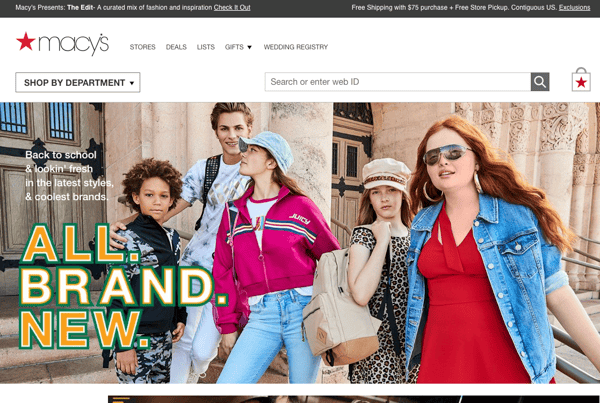
Novelty words are generally useful for Back to School campaigns because the first day of school is new, and students want to feel new and cool and fresh.
Using psychographic data to understand which psychological principles your customers respond to best will help optimize your Back to School campaigns.
Use focus groups, data, or interviews to get a 360-view of your customer so that you can guide them in the best way throughout their journeys.
Parents are mostly utilitarian (read about utilitarian vs. hedonic shopping states) back-to-school shoppers, meaning they want to find cheap and practical supplies for their kids in a fast and efficient way.
What matters the most is price, product, and convenience.
Therefore, make the shopping experience easy and product information readily available.
You could use bundles!
Like, an all-in-one purchase of a black backpack, black lunch box, and black 2019 journal. Or: a marble laptop case, marble pens, and maybe even throw in some marbles for the heck of it!
In one click, parents can buy all these supplies together at an overall discounted price, from cases to crayons.
Create frictionless buying experiences to facilitate decision-making, cognitive fluency, and reduce hesitation.
Speaking of cases and crayons - make sure you don’t have too much choice overload.
Back to School is in itself a rush with plenty of options already, and you don’t want to add to the shopper’s anxiety by being too complex and having too much to choose from.
Instead, minimalistic web designs and grouping Back to School essentials together in an organized way will relieve the psychological stress of shopping by reducing decision fatigue (see more persuasive pricing techniques here), and influence customers to buy more.
Moreover,
Make checking-out as frictionless as possible.
You are, after all, competing with the likes of Amazon, whose one-click checkout will be the saving grace for parents running out of shopping time.
Generating ease and convenience as back-to-school shoppers make decisions across the marketing funnel ties in with our second to last tip...
...Which is the cherry on top for your shoppers.
62% of shoppers will spend less in one go than they did previously. The pandemic has increased financial frugality. More and more parents are getting pre-season anxiety relating to the pressures back to school spending and post-pandemic behavior.
Equip your marketing channels with desirable deals and discounts, designed to appeal to deal-hungry shoppers, but remember not to force purchases on your consumers.
Instead, customize deals depending on who you are engaging with (I for one am a big believer in the promo code).
In addition to this,
71% of shoppers use online carts to evaluate shipping fees and return policies.
Imagine this scenario:
I’m a parent of three. My kids claim they want to look 'fresh' (their words, not mine) when going Back to School.
But Charlie, the youngest, is on a massive growth spurt, so will these clothes even fit him? This causes hesitation before checkout.
But your webshop provides very few checkout stages and loads of product information. I also see that I can checkout using PayPal, which is great for me because I have a foreign card.
Then I see “Free Shipping” and “Free Returns” and all hesitation is removed.
Actually, over 46.5% of MSMEs say that free shipping increases their profits.
Take Amazon’s Back to School section, which is completely deal-driven.
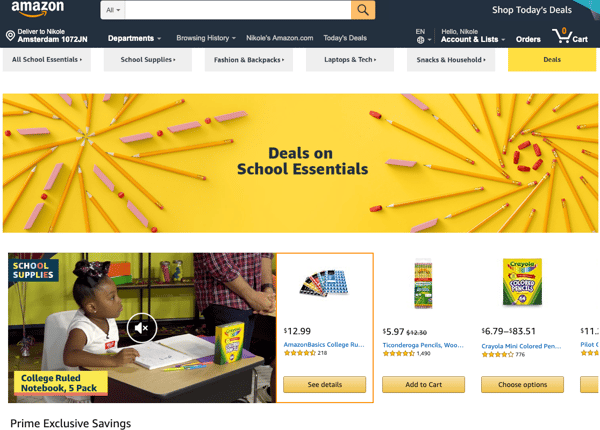
In fact, Amazon’s whole Back to School web page is designed on the basis of a discounted purchasing experience, with prime exclusive savings, and the product tag “deal of the day” on various supplies-bundles.
And there it is again: their one-click checkout provides a convenient and affordable fulfillment option, which helps them thrive during back to school School season.
During checkout, a good way to nudge people not to abandon their carts is by using trust symbols, which leverages Cialdini’s principle of “Authority”.
![]()
These badges will ensure key customer protection guarantees, reduces the emphasis on the cost, increases trust, and drives conversions.
How do you bring existing customers back to your webshop?
For one, retarget them using email campaigns, ads, and content based on your newly improved and optimized Back to School strategy.
Which you’ve told all your departments about, right? With your strategy solid from marketing to merchandise, you can roll it out omnichannel.
Good.
Now, retarget, because existing customers will spend 67% more than new ones.
Highlight in your copy new Back to School themed discounts to pique the curiosity of previous customers.
We’ve all seen that seasonal email that offers such a big discount that it’s almost impossible not to click on it:
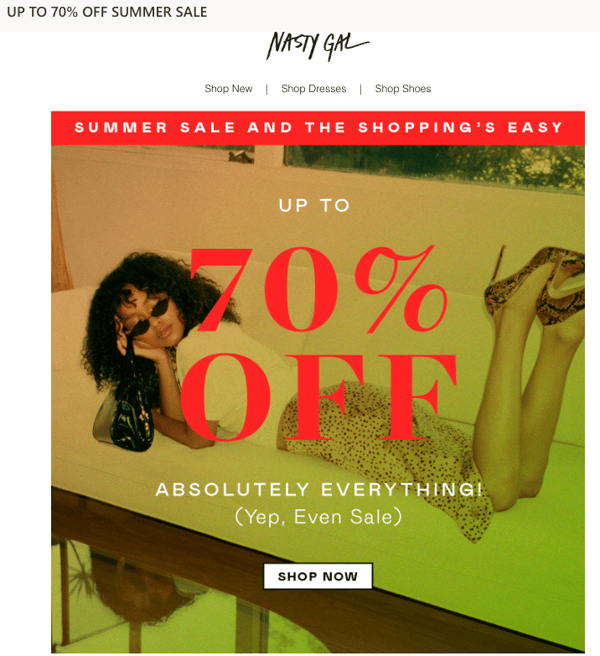
Retargeting can also be achieved by offering customer loyalty programs. In this case, give Back to School promotions to your existing customer base online or in-store (i.e. giveaways).
Even though parents are utilitarian and want to fast-track the Back to School shopping process, that doesn’t exempt them from emotional marketing.
After all, Back to School represents their kids coming of age and leaving the nest. It’s important that you stay connected with your customers on an emotional level (especially given this year’s financial pressures).
Collect data on the grades your customers are heading into to customize your campaign copy and tailor your product offerings.
Show your customers that you care and that you understand them.
Take inspiration from this TESCO ad... which is just super cute:

Moreover,
More than 30% of parents plan to compare prices online before purchasing.
So,
Be the eCommerce store that centralizes all the information necessary for Back to School shopping, including price comparisons and quality reviews.
Foster an intimate relationship with your customers, leveraging emotion and appealing to the sensitive nature of going Back to School.
Like Gap!
Their Back to School commercial “Mantra” shows a class of kids chanting motivating lines back at their teacher such as, “we can do anything we put our minds to”.
It’s simple, it’s short, it’s emotional – and wouldn't you full-on sprint to your nearest Gap after watching it?
Despite the effect of the pandemic on retail, Back to School remains one of the year's massive opportunities.
To opt out of leveraging this trend as a retail store would be to seriously miss out on increased revenue and brand awareness.
Even if you don’t sell apparel or electronics, Back to School permeates all industries from food to furniture.
You can’t escape it!
So, use these seven ways to stay relevant, get ahead of the curve, and increase customer engagement omnichannel.